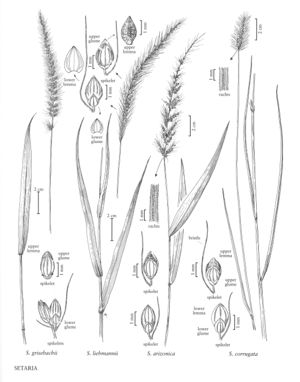Setaria grisebachii
Plants annual. Culms 30-100 cm; nodes pubescent, hairs appressed. Sheaths with ciliate margins; ligules ciliate; blades to 12 (25) cm long, to 10 (20) mm wide, flat, hispid on both surfaces. Panicles 3-18 cm, loosely spicate, interrupted, often purple; rachises hispid; bristles 1-3, 5-15 mm, flexible, antrorsely scabrous. Spikelets 1.5-2.2 mm. Lower glumes about 1/3 as long as the spikelets, distinctly 3-veined, lateral-veins coalescing with the central veins below the apices; upper glumes nearly equaling the upper lemmas, obtuse, 5-veined; lower lemmas equaling the upper lemmas; lower paleas about 1/3 as long as the lower lemmas, narrow; upper lemmas finely and transversely rugose; upper paleas similar to the upper lemmas. 2n = unknown.
Distribution
Md., Ariz., Okla., N.Mex., Tex.
Discussion
Setaria grisebachii is the most widespread and abundant native annual species of Setaria in the south-western United States. It grows in open ground and extends along the central highlands of Mexico to Guatemala, usually at elevations of 750-2500 m. The specimens from Maryland were collected on chrome ore piles; the species is not established in the state.
Selected References
None.
Lower Taxa
"decumbent" is not a number.
